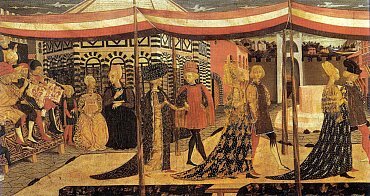Accademia Gallery: works not to be missed

The Accademia Gallery in Florence is really full of works of art to see and admire. But here we mention the most important ones, the works that you definitely have to see at your first visit.
Michelangelo's David
It was 1501 when Michelangelo was recalled to Florence for a commission of the Opera del Duomo. He was asked to work on a statue of immense proportions to make a David, with the constraint of carving it from a big block of marble lying abandoned in the courtyard of the Opera del Duomo. The marble block had already been entrusted to two sculptors, Agostino di Duccio and Antonio Rossellino, but both had left the project due to numerous imperfections of the material. Michelangelo accepted the challenge, and until 1504 he worked incessantly to the realization of the David. In his work he represented David, the biblical hero, the moment before facing the giant Goliath, without sword but with only his sling, completely naked, armed with strong faith in God, rationality and intellect. The statue was certainly inspired by the aesthetics of classical culture, but embodies the man-hero of the Renaissance, the protagonist of history aware of his capabilities. The statue, 4.10 meters high and weighing five tons was placed in front of the Palazzo della Signoria, where today you can find a copy.
Michelangelo's Prisoners
Anothor important work by Michelangelo, the Prisoners are four imposing statues whose fame is mainly due to their suggestive and powerful unfinished condition. You can admire them along the corridor of the museum and they can be dated to a period between 1519 and 1534. The Prisoners are an example of the practice used by Michelangelo called "unfinished".The four sculptures are in fact not perfectly smooth, but have been deliberately left in an incomplete stage to communicate one of the deepest themes of human imperfection. They exude a sense of tension, motion, a struggle of the figure that seems trying to escape from the marble as well as the human spirit that tries to free himself from the flesh to yearn for God.
Model for the Rape of the Sabine Women
The Galleria dell'Accademia houses the preparatory plaster model of the Rape of the Sabine Women by Giambologna. The work, of considerable size, strikes for its large dimensions and for refined laying of naked bodies which form a spiral movement. With this preparatory model Giambologna studied in minute detail the group to be carved a marble 10.4 meters high.
Adimari marriage chest
This is the front part of a wedding chest of the XV century or, according to recent studies, the panel of a crib headborard. In any case the connection to the Adimari family is given from the setting of the wedding scene represented, namely the initial part of Via de' Calzaiuoli that was once called Corso Adimari, where were located numerous possessions of the family. The marriage depicted near the Baptistery of San Giovanni would presumably be that of Adimari-Ricasoli in 1420 or Adimari-Hammers occurred within 1450. The pan is attributed to the Scheggia, younger brother of Tommaso de' Cassai, better known in Florence as Masaccio.
Coronation of the Virgin by Jacopo di Cione
The main work on display in the Orcagna hall from February 2014 is the majestic "Coronation of the Virgin" by Jacopo di Cione, fully renovated in 2011. The painting is also known as the "Coronation of the Mint" as commissioned by the officers of the Florentine magistrates who superintended the minting of the Fiorino. The table was placed in the former headquarters of the Mint, then transferred to the Uffizi and the Accademia Gallery, finally. In the splendid Pala is depicted the Coronation of the Virgin, on an elegant higher floor compared to patron saints of the city of Florence. In this context the religious subject merges with the civic and political sense represented by the symbols in the frame carved, gilded and painted.











